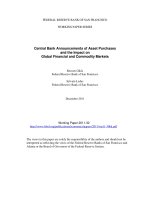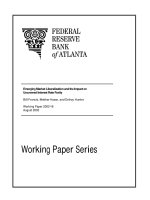Financial accounting the impact on decision makers 9e chapter 13
Bạn đang xem bản rút gọn của tài liệu. Xem và tải ngay bản đầy đủ của tài liệu tại đây (1.75 MB, 35 trang )
Chapter 13
Financial Statement Analysis
Limitations and Considerations in
Financial Statement Analysis
Watch for alternative accounting principles
Selection of a inventory valuation method
Changes in accounting method
Take care when making comparisons
Recognizing trends in ratios
Extra caution for extraordinary items and gains and
losses from discontinued operations
LO 1
Limitations and Considerations in
Financial Statement Analysis (continued)
Understand the possible effects of inflation
Financial statements are based on historical costs
and are not adjusted for the effects of increasing
prices
Analysis of Comparative Statements:
Horizontal Analysis
Comparison of financial statement items over a period
of time
LO 2
Example 13.1—Preparing and Reading
Comparative Balance Sheets—Horizontal Analysis
Example 13.2—Preparing and Reading Comparative Statements of
Income and Retained Earnings—Horizontal Analysis
Example 13.3—Preparing and Reading Comparative
Statements of Cash Flows—Horizontal Analysis
Analysis of Common-Size Statements:
Vertical Analysis
Comparison of various financial statement
items within a single period with the use of
common-size statements
Common-size statements recast items as a
percentage of a selected item
LO 3
Example 13.4—Preparing and Reading
Common-Size Balance Sheets—Vertical Analysis
Example 13.5—Preparing and Reading
Common-Size Income Statements—Vertical Analysis
Liquidity Analysis
A relative measure of the nearness to cash of the
assets and liabilities of a company
LO 4
Working Capital
The excess of current assets over current liabilities at a
point in time
Current Ratio
The ratio of current assets to current liabilities
One of the most widely used financial statement
ratios
Acid-Test Ratio
A stricter test of liquidity than the current ratio
Excludes inventory and prepayments from the
numerator
Cash Flow from Operations to Current
Liabilities
A measure of the ability to pay current debts from
operating cash flows
Accounts Receivable Analysis
Accounts receivable turnover ratio: a measure of the
number of times accounts receivable are collected in a
period
Number of days’ sales in receivables: a measure of the
average age of accounts receivable
Inventory Analysis
Inventory turnover ratio: a measure of the number of
times inventory is sold during a period
Number of days’ sales in inventory: a measure of how
long it takes to sell inventory
Cash-to-Cash Operating Cycle
The length of time from the purchase of inventory to
the collection of any receivable from the sale
Solvency Analysis
The ability of a company to remain in business over
the long term
The ability of the firm to stay financially healthy over
the period of time that existing debt (short- and
long-term) is outstanding
LO 5
Debt-to-Equity Ratio
The ratio of total liabilities to total stockholders’
equity
The composition of debt and equity is an important
determinant of the cost of capital to a company
Times Interest Earned Ratio
Indicates the company’s ability to meet the current
year’s interest payments out of the current year’s
earnings
Debt Service Coverage Ratio
Measure of the amount of cash that is generated from
operating activities during the year and that is
available to repay interest due and any maturing
principal amounts
Cash Flow from Operations to Capital
Expenditures Ratio
A measure of the ability of a company to finance longterm asset acquisitions with cash from operations
Profitability Analysis
How well management is using company resources to
earn a return on the
= funds invested by various groups
Two frequently used profitability measures:
Gross Profit Ratio =
Profit Margin Ratio =
Gross Profit
Net Sales
Net Income
Net Sales
LO 6
Rate of Return on Assets
A measure of a company’s success in earning a return
for all providers of capital









